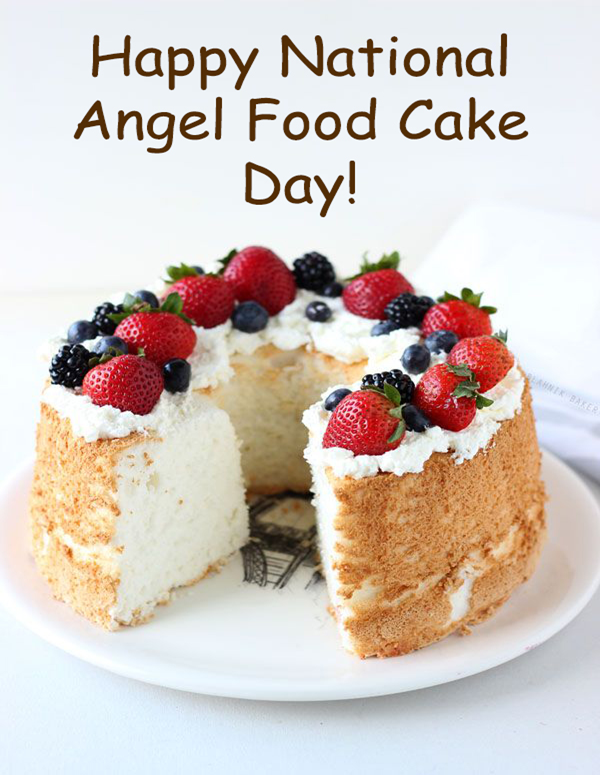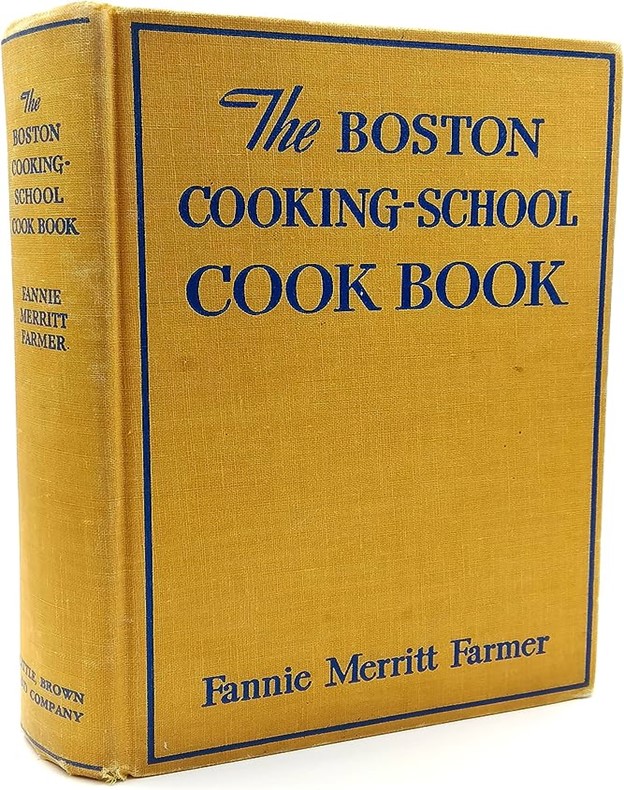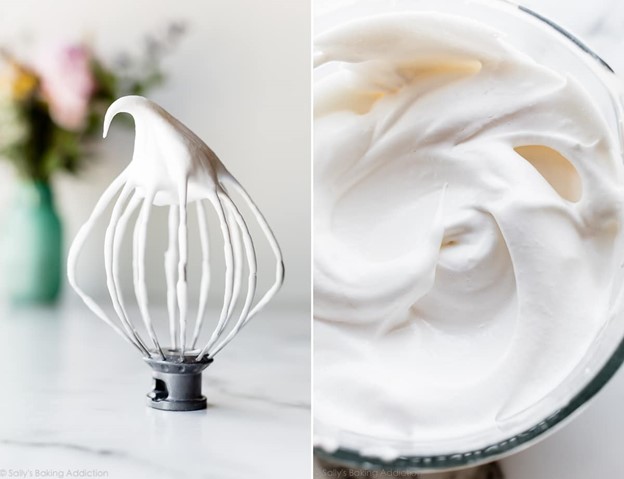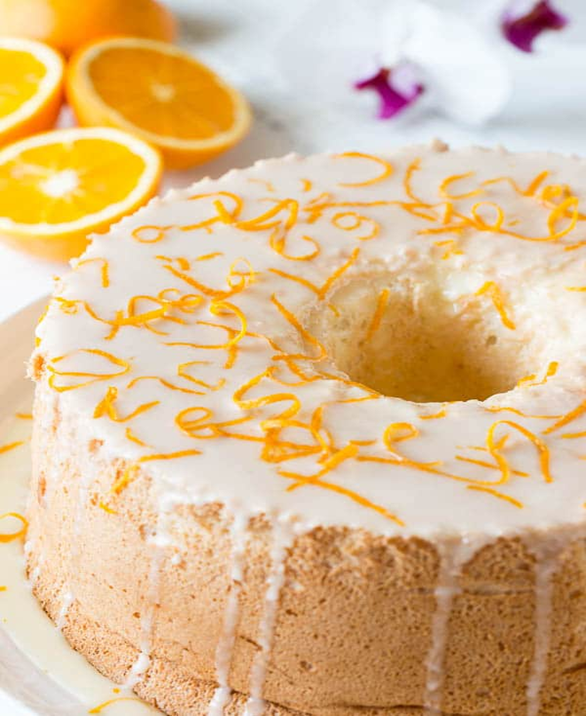In Honor of This Breath-Taking Holiday…
Hold onto your hat. Did you know October 10 is National Angel Food Cake Day? It’s true—I have no reason to make this up!

This long-awaited day celebrates the delicious, light, and fluffy cake that many home cooks serve with fruit or glazes.
History says angel food cake was first developed in the 1880s in St. Louis, Missouri. The first detailed recipe of this cake was published in the Boston Cooking School Cook Book in 1884. Its popularity spread quickly. People loved its airy lightness. It was nicknamed the “food of the angels.”

For any of you new to the angel food cake realm, making it requires whipping egg whites until they are stiff. Cream of tartar stabilizes the egg whites. Additional ingredients are then folded into the egg white mixture.
It’s then baked in an ungreased tube pan, leaving a hole in the middle of the cake. The center tube allows the cake batter to rise higher than other pans would, causing the batter to cling to all sides of the pan. After baking, the pan is inverted while cooling to prevent the cake from falling in on itself.

The type of pan in which it’s baked is important. While a bundt pan has a tube, it can’t be successfully substituted for a traditional angel food cake pan. It’s typically fluted and has a non-stick coating. Neither feature will support an angel food cake batter.
While you can make Bundts, coffee cakes, and similar cakes in a tube pan, this shape and type of pan is ideal for cakes with a light and airy crumb like angel food or chiffon cakes.
Angel food cake recipes don't typically contain leaveners; the air whipped into the egg white-based batter is what makes them so lofty. This is why a straight-sided pan that's uncoated (and ungreased) is needed; the batter must cling to the sides of the pan as it expands and be able to rise up tall.

Once the cake is out of the oven, the pan is inverted (as mentioned above), so it can cool upside down. This is why tube pans often have removable bottoms and "feet"—they prevent the delicate cake from collapsing and make it much easier to remove the cake from the pan after it cools.
Usually, rather than frosting, angel food cakes are topped with a glaze or a sweet fruit sauce and a swirl of whipped cream. But two favorite ways to use it is in making trifle and parfaits. The airy layers absorb the flavors of fruit, caramel, liqueurs, and chocolate well.

This delicious cake has been around for over a hundred years, and rightly so. It’s such a versatile dessert. It’s also considered a fairly healthy option to traditional cakes because of the absence of fat in its recipe and being lower in calories. For instance, when comparing it to a Devil’s Food cake, ounce for ounce, the devil’s food cake contains calories: without frosting, a 1.5-ounce slice of devil’s food cake has 160 calories versus the angel food cake at 110 calories.
In honor of this breath-taking holiday, here’s one of our favorite angel food cake recipes. It’s from Gale Gand of www.foodnetwork.com. While you can simplify with a box mix, it’s well worth the time, cost, and effort to make it from scratch. I hope you like it as much as we do, and happy holiday!

CAKE
1 1/2 cups egg whites (from about 1 dozen eggs), at room temperature
1 1/4 teaspoons cream of tartar
1/2 teaspoon salt
1 cup sugar plus 1/2 cup
1 1/8 cups sifted cake flour
1 teaspoon vanilla extract
1 orange zested
GLAZE
3/4 cup orange juice
1 1/2 pounds confectioners' sugar
Directions:
Add Recipe to Cook'n
blog comments powered by Disqus

This long-awaited day celebrates the delicious, light, and fluffy cake that many home cooks serve with fruit or glazes.
History says angel food cake was first developed in the 1880s in St. Louis, Missouri. The first detailed recipe of this cake was published in the Boston Cooking School Cook Book in 1884. Its popularity spread quickly. People loved its airy lightness. It was nicknamed the “food of the angels.”

For any of you new to the angel food cake realm, making it requires whipping egg whites until they are stiff. Cream of tartar stabilizes the egg whites. Additional ingredients are then folded into the egg white mixture.
It’s then baked in an ungreased tube pan, leaving a hole in the middle of the cake. The center tube allows the cake batter to rise higher than other pans would, causing the batter to cling to all sides of the pan. After baking, the pan is inverted while cooling to prevent the cake from falling in on itself.

The type of pan in which it’s baked is important. While a bundt pan has a tube, it can’t be successfully substituted for a traditional angel food cake pan. It’s typically fluted and has a non-stick coating. Neither feature will support an angel food cake batter.
While you can make Bundts, coffee cakes, and similar cakes in a tube pan, this shape and type of pan is ideal for cakes with a light and airy crumb like angel food or chiffon cakes.
Angel food cake recipes don't typically contain leaveners; the air whipped into the egg white-based batter is what makes them so lofty. This is why a straight-sided pan that's uncoated (and ungreased) is needed; the batter must cling to the sides of the pan as it expands and be able to rise up tall.

Once the cake is out of the oven, the pan is inverted (as mentioned above), so it can cool upside down. This is why tube pans often have removable bottoms and "feet"—they prevent the delicate cake from collapsing and make it much easier to remove the cake from the pan after it cools.
Usually, rather than frosting, angel food cakes are topped with a glaze or a sweet fruit sauce and a swirl of whipped cream. But two favorite ways to use it is in making trifle and parfaits. The airy layers absorb the flavors of fruit, caramel, liqueurs, and chocolate well.

This delicious cake has been around for over a hundred years, and rightly so. It’s such a versatile dessert. It’s also considered a fairly healthy option to traditional cakes because of the absence of fat in its recipe and being lower in calories. For instance, when comparing it to a Devil’s Food cake, ounce for ounce, the devil’s food cake contains calories: without frosting, a 1.5-ounce slice of devil’s food cake has 160 calories versus the angel food cake at 110 calories.
In honor of this breath-taking holiday, here’s one of our favorite angel food cake recipes. It’s from Gale Gand of www.foodnetwork.com. While you can simplify with a box mix, it’s well worth the time, cost, and effort to make it from scratch. I hope you like it as much as we do, and happy holiday!

Orange Angel Food Cake
Ingredients:
CAKE
1 1/2 cups egg whites (from about 1 dozen eggs), at room temperature
1 1/4 teaspoons cream of tartar
1/2 teaspoon salt
1 cup sugar plus 1/2 cup
1 1/8 cups sifted cake flour
1 teaspoon vanilla extract
1 orange zested
GLAZE
3/4 cup orange juice
1 1/2 pounds confectioners' sugar
Directions:
1. Preheat the oven to 375 degrees F.
2. In a mixer fitted with a whisk attachment (or using a hand mixer), whip the egg whites until foamy. Add the cream of tartar and salt and continue whipping until soft peaks form.
3. With the mixer running, gradually add 1 cup of the sugar and continue whipping until stiff and the sugar has dissolved, about 30 seconds.
4. Sift the remaining 1/2 cup sugar with the pre-sifted cake flour 3 times, to aerate the mixture.
5. Fold into the egg whites, then fold in the vanilla, and zest.
6. Spoon the batter into an ungreased tube pan. Bake until light golden brown, 25 to 30 minutes. Cool by turning the cake (in the pan) upside down until it cools to room temperature. Run a long, sharp knife blade around the cake to loosen, then knock the cake out onto a plate, or work it out with your fingers. The outside of the cake will remain in the pan leaving the cake whiter and more angelic looking.
7. Make the glaze: Stir the ingredients together until smooth. Spoon the glaze generously over the cake top so it drips down the cake sides. Let set for at least 30 minutes before serving, or until the glaze is set. Suggestion: serve with sorbet.
2. In a mixer fitted with a whisk attachment (or using a hand mixer), whip the egg whites until foamy. Add the cream of tartar and salt and continue whipping until soft peaks form.
3. With the mixer running, gradually add 1 cup of the sugar and continue whipping until stiff and the sugar has dissolved, about 30 seconds.
4. Sift the remaining 1/2 cup sugar with the pre-sifted cake flour 3 times, to aerate the mixture.
5. Fold into the egg whites, then fold in the vanilla, and zest.
6. Spoon the batter into an ungreased tube pan. Bake until light golden brown, 25 to 30 minutes. Cool by turning the cake (in the pan) upside down until it cools to room temperature. Run a long, sharp knife blade around the cake to loosen, then knock the cake out onto a plate, or work it out with your fingers. The outside of the cake will remain in the pan leaving the cake whiter and more angelic looking.
7. Make the glaze: Stir the ingredients together until smooth. Spoon the glaze generously over the cake top so it drips down the cake sides. Let set for at least 30 minutes before serving, or until the glaze is set. Suggestion: serve with sorbet.
Recipe formatted with the Cook'n Recipe Software from DVO Enterprises.
 Alice Osborne
Alice Osborne
DVO Newsletter Contributor since 2006
Email the author! alice@dvo.com
Sources:
- www.deviantart.com
- www.amazon.com
- www.sallysbakingaddiction.com
- www.thatskinnychickcanbake.com
- www.sweetandsavorybyshinee.com
